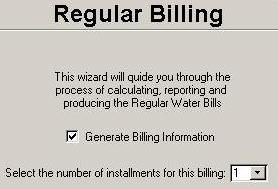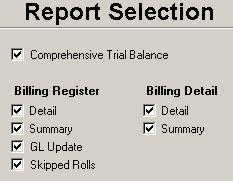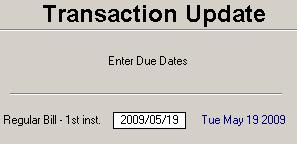Introduction There are two types of billings: Regular and Manual Adjustment. The
Regular billing is usually done by batch according to a set schedule that has been approved by council. The Manual Adjustment billing is quite similar. With the Manual Adjustments billing, several different
temporary charges can be added to a roll during the year. If a property is sold, or there is trouble with a meter and the water has to be shut off at the curb, the municipality could charge for this extra
work. If you need to do manual billing adjustments, a Final/Closing billing, Opening billing, extra pool fill up, or anything else for which you want to send a bill to the property owner, you will need to first
enter the data into the Billing Adjustment
screen. Manual billings are done in batches too. All rolls in the current batch will be included in the billing.No matter what the billing type, to get a bill, each account must have an owner or
tenant with a sequence number of 001, a mailing address, some billing charges assigned and have a check in the connected to the municipal water system box. This wizard walks you through the Regular billing.
The billing process has been broken down into small chunks to make it as easy as possible.
 Step 1: Select Billing Step 1: Select Billing

Select which billing to be run and a batch. The next batch number will automatically be
selected. If the chosen billing batch has already been updated, you will be limited to only printing reports. When you are content with your selection, click the Next button.
If you selected a billing that had been started but was cancelled out, then
 Step 2: Generate Step 2: Generate
This step records the current status of the system and sets up data for several reports. No data is changed  at this step, but the status is saved and used during the billing. The first time through this screen for each billing
batch, you must generate the billing information. If your reports provided to you in the next step show something is wrong, then correct the problem and regenerate so the
current status is re-saved. If you want to regenerate, place a check mark in the box to the left of Generate Billing Information by clicking in it with the mouse. As well, on this
screen you are also given a chance here to change the number of installments that will be used for this billing. Changing the number of
installments will require the billing to be regenerated. When you are ready, click the Next button. at this step, but the status is saved and used during the billing. The first time through this screen for each billing
batch, you must generate the billing information. If your reports provided to you in the next step show something is wrong, then correct the problem and regenerate so the
current status is re-saved. If you want to regenerate, place a check mark in the box to the left of Generate Billing Information by clicking in it with the mouse. As well, on this
screen you are also given a chance here to change the number of installments that will be used for this billing. Changing the number of
installments will require the billing to be regenerated. When you are ready, click the Next button.
 Step 3: Report Selection Step 3: Report Selection
 Several different reports are generated during a billing. If you notice a check box that is greyed out, that means its report contains no data. Below is a
list of each report with a short description: Several different reports are generated during a billing. If you notice a check box that is greyed out, that means its report contains no data. Below is a
list of each report with a short description:
- Comprehensive Trial Balance: Shows all
rolls that have outstanding amounts owing or credits. As well, the Comprehensive Trial Balance (Billing), which is for rolls included in the
current billing, also appears.
- Billing Register Section:
Detail:
The Water Bill Register shows each roll in the billing along with the amount it will be billed. This report is sorted by Service Area. Each Service Area section concludes with its totals
- Summary:
The total lines for each Service Area for the Water Bill Register appear on this report.
- GL Update:
The transactions that will be put into the GL appear on this report. This report must balance.
- Skipped Rolls:
Rolls that will not be included in this billing are listed on this report.
- Billing Detail Section:
The Water Bill Detail report contains the breakdown of how the charges were calculated. This is most important for metered billings. Also
sorted by Service Area, each section has its own totals line.
- Summary:
The totals of the Water Bill Detail report are shown here.
Clicking the Next button will make all selected report appear on the screen.
 Step 4: Checklist Step 4: Checklist
 Make sure everything balances and that
a backup has been done before proceeding. After this step, transactions will be put into the system. In the event of an error, you will need to either regenerate the billing, Step 2 above, or restore from backup. After you do a step in the checklist, put a
check into its box by clicking in its box. Once all three boxes have check marks, the Next button will be enabled, so you can continue on to Step 5. Make sure everything balances and that
a backup has been done before proceeding. After this step, transactions will be put into the system. In the event of an error, you will need to either regenerate the billing, Step 2 above, or restore from backup. After you do a step in the checklist, put a
check into its box by clicking in its box. Once all three boxes have check marks, the Next button will be enabled, so you can continue on to Step 5.

Step 5: Due Dates
 Depending on the number of installments you chose during Step 2, you will see either one or two due dates on this screen.
Simply enter in the dates by which you wish each installment to be paid. The computer automatically calculates the first date as 21 days from the current system date. Three weeks is a standard minimum
time from the post marked date for bills to be due. If your bylaw has a different date, you must change it here now. If there is a second date, then it is calculated as 28 days
from the first installment date. The 28 was chosen as the default since it will always be a weekday if the first date is a weekday. Click the Next button when the dates are correct. Depending on the number of installments you chose during Step 2, you will see either one or two due dates on this screen.
Simply enter in the dates by which you wish each installment to be paid. The computer automatically calculates the first date as 21 days from the current system date. Three weeks is a standard minimum
time from the post marked date for bills to be due. If your bylaw has a different date, you must change it here now. If there is a second date, then it is calculated as 28 days
from the first installment date. The 28 was chosen as the default since it will always be a weekday if the first date is a weekday. Click the Next button when the dates are correct.
 Step 6: Second Trial Balance Step 6: Second Trial Balance
 The Comprehensive Trial Balance plus the amounts on the Levy Summary, both printed in Step 3, should
equal the total on the Comprehensive Trial Balance that is printed here. When you have a check mark in the Trial Balance box and click Next the post Comprehensive Trial Balance will appear on the
screen. As well, after clicking the Next button, you will see a couple message boxes like "Generating information required for Regular Bills..." and "Generating Names" while the
bills are being built. When you close the report, Step 7 will appear. The Comprehensive Trial Balance plus the amounts on the Levy Summary, both printed in Step 3, should
equal the total on the Comprehensive Trial Balance that is printed here. When you have a check mark in the Trial Balance box and click Next the post Comprehensive Trial Balance will appear on the
screen. As well, after clicking the Next button, you will see a couple message boxes like "Generating information required for Regular Bills..." and "Generating Names" while the
bills are being built. When you close the report, Step 7 will appear.
 Step 7: Print Water Bills Step 7: Print Water Bills
 This step will print the bills. If any
bulked rolls, or accounts that have signed up for the Pre-Authorized Payment Plan, are included in the billing, there will be a check in the Mortgage/PAPP Water bills box too. When the printer has trouble, and you
have to cancel the print job, you do not have to start over. Each bill has a grey bill number in the bottom left corner. Put the number of the bill that you wish to print next into the Start at Bill # box
to save yourself some time. This step will print the bills. If any
bulked rolls, or accounts that have signed up for the Pre-Authorized Payment Plan, are included in the billing, there will be a check in the Mortgage/PAPP Water bills box too. When the printer has trouble, and you
have to cancel the print job, you do not have to start over. Each bill has a grey bill number in the bottom left corner. Put the number of the bill that you wish to print next into the Start at Bill # box
to save yourself some time.If you are only going to have one installment, you could put a message into the Installment 1 box like, "There is only one installment for this billing." Or you could use
this to announce a historic Municipal event like an upcoming festival. The choice is yours. If you chose to have two installments, then you will have two boxes, one for
each installment, into which you can add some kind of message. Clicking the Next button will show the selected bills on the screen.

Step 8: Print Mortgage/Bulk List
 The Mortgage/Bulk List includes all rolls that have something in their Bank column on the Water Bill Register report. These rolls may be properties that
are grouped by owner, or that all have signed up for the Pre-Authorized Payment Plan and are grouped by the bank code. This idea was taken from our
Tax system. The owners of bulk properties may wish to have a concise list of their properties, the amounts billed for each, and a total owing amount.
The Mortgage/Bulk List includes all rolls that have something in their Bank column on the Water Bill Register report. These rolls may be properties that
are grouped by owner, or that all have signed up for the Pre-Authorized Payment Plan and are grouped by the bank code. This idea was taken from our
Tax system. The owners of bulk properties may wish to have a concise list of their properties, the amounts billed for each, and a total owing amount.
 Step 9: Complete Step 9: Complete
 Do not click the Finish button until you are
sure everything went through properly and that all bills were printed. When you do click the Finish button, a few will things happen. The billing is marked as being completed, the next batch number is
incremented, and the transactions that are pending from the billing are made permanent. You should now print the GL Update report and transfer the transactions to the General Ledger. Do not click the Finish button until you are
sure everything went through properly and that all bills were printed. When you do click the Finish button, a few will things happen. The billing is marked as being completed, the next batch number is
incremented, and the transactions that are pending from the billing are made permanent. You should now print the GL Update report and transfer the transactions to the General Ledger.
|